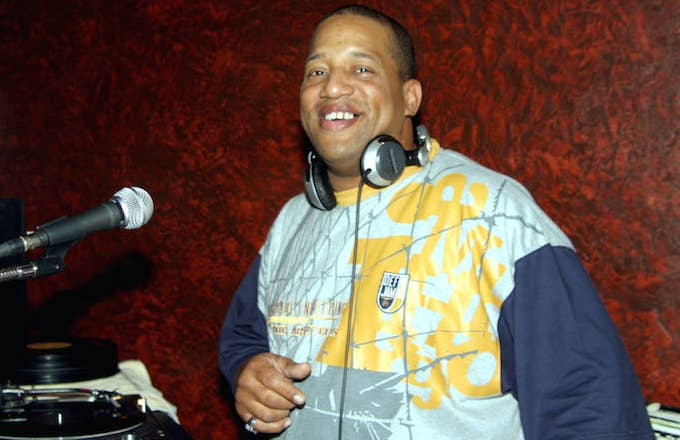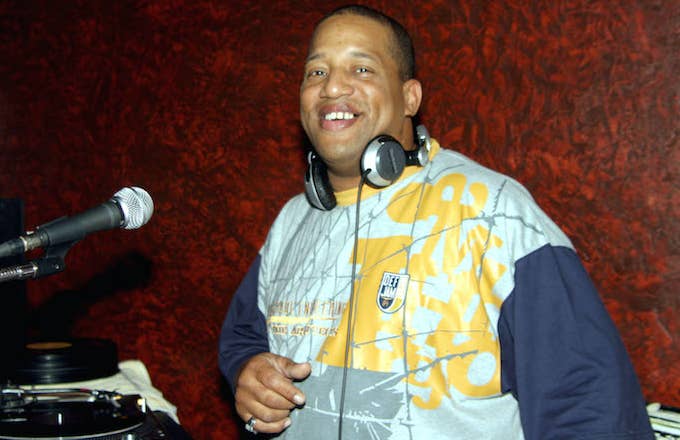
This piece is adapted from Zack O’Malley Greenburg’s new book, 3 KINGS: Diddy, Dr. Dre, Jay-Z and Hip-Hop’s Multibillion-Dollar Rise, sourced from what appears to be Lovebug Starski’s last major sit-down interview before his untimely passing in February. Zack is the senior editor of media & entertainment at Forbes.

By Zack O'Malley Greenburg
Lovebug Starski may be best known for getting shouted out by Notorious B.I.G. in “Juicy,” the 1994 hit produced by Diddy and later sampled by Jay-Z. The song, however, makes no mention of Starski’s chief contribution to hip-hop: though he didn’t invent the genre, he may well have been the first to give it a name.
“I would do a rhyme and I would get stuck for a couple of words, and I would just go, ‘Then you rock the hip, then you rock the hop, a hip-hop a hippi, da hop hop hippi hippi . . .’” he explains, recalling his early days as a pioneering rapper-DJ in New York (adding that he was rapping with the late Cowboy, one of the wordsmiths of Grandmaster Flash and the Furious Five, when he first developed the term “hip-hop”). “And it caught on because I’d be doing it in the rhythm of the record.”
He says this sitting at my dining room table, eating takeaway from a five-dollar sushi buffet after declining my offer to take him out for lunch. Starski is nearing age sixty, much older and heavier now than in the faded YouTube videos he shows me on his phone, in which he skips across a pastel stage jovially delivering Dr. Seuss–style rhymes. Today he speaks obliquely about his declining health and tattered finances, wheezing occasionally, but then he’ll toss in a detail like the price of his coat: $1,700. Or he’ll laugh—a booming, subterranean sort of guffaw that makes it sound as though he just ate a subwoofer—usually while reminiscing about his early days.
Born Kevin Smith in the South Bronx, the aspiring DJ fell in with a gang called the Black Spades. “At first my name was Kool DJ Kev,” he says. “Not catchy.” While watching a Herbie the Love Bug film with some fellow gang members, his stage name simply erupted from his brain. “I looked up at the screen . . . I said, ‘I’m the l-o-v-e the b-u-g!’” he raps to me. “I just kept doing it and doing it, and got kicked in the head with a fucking army boot by a female Spades member.” The second part of his name came to him in rhyme, too: “Like a crippled crab without a crutch, it’s Starski without a Hutch.”
Following close on the heels of his friend Anthony “DJ Hollywood” Holloway, Starski became one of the first rapping DJs to emerge from the disco scene in the 1970s, and many better-known wordsmiths have gotten rich cribbing his rhymes. As journalists started covering hip-hop, though, the narrative of its origins coalesced around the easily packaged idea of a holy trinity of founders: Afrika Bambaataa, DJ Kool Herc, and Grandmaster Flash.
All three deserve recognition as much as anyone, but trying to accurately pinpoint three—or even five—originators of a movement with as many diverse influences as hip-hop is tricky. The trinity concept leaves out forerunners like Jalal “Lightnin’ Rod” Nuriddin, a member of the civil rights–era group the Last Poets. His 1973 spoken-word album, an underworld Iliad known as Hustlers Convention, has caused many to dub him the grandfather of rap. “All the candy rappers got my money,” Lightnin’ Rod complained when I spoke with him in 2016. (He said that he had known Jay-Z’s father. But when I asked if he’d tell me more for the book, he demanded compensation, and I declined per journalistic principle.)
Others with a claim include Brooklyn DJ Grandmaster Flowers, disco group the Fatback Band, jazz poet Gil Scott-Heron, smooth-talking midcentury radio personalities like Frankie Crocker and Jocko Henderson, swaggering rhymester Muhammad Ali, and scatting jazz legend Louis Armstrong. Hip-hop’s lineage could even be traced as far back as the troubadours of West Africa, called griots, who’ve engaged in spoken-word storytelling for ages. For Lightnin’ Rod, Starski, and their ilk, there’s a palpable bitterness toward the movement they helped create. They feel ignored by the three kings’ generation; occasional lip service isn’t enough.
“Puffy would never walk up to me and say, ‘What up, Lovebug, you all right?’” says Starski, raising his voice as he plays out the hypothetical encounter. “‘Hell no, motherfucker! Put a million in my pocket! . . . I don’t want no photo op with your ass, 'cause it don’t mean nothing. I can’t take it down to the subway and get on the train with it.’”
The likes of Flash and Fab 5 Freddy still earn a comfortable living plying their respective trades within the framework of hip-hop (“It was Lovebug who popularized that word, between him and Hollywood,” says Fab). But the same can’t be said of most of the pioneers, even one of those whose lyrics were used without permission in “Rapper’s Delight,” the first hip-hop song to crack the pop charts.
“I came up with all those rhymes, you know?” says Starski, his eyes suddenly misty. “It was real good times, Zack, innocent times. We were all innocent. Nobody knew nothing about business.”
***
The cultural and economic realities of Starski’s home turf in the South Bronx and nearby Harlem during the 1970s were separated by a gulf far wider than the narrow river that divides them. In the Bronx, things got so bad that landlords would pay to have their own apartment buildings burned down, often shelling out as little as fifty dollars to petty criminals in hopes of earning a low-six-figure insurance payout (a fate suffered by Starski’s first childhood home). One fire, visible from a 1977 World Series game at Yankee Stadium, prompted commentator Howard Cosell to famously declare, “There it is, ladies and gentlemen: the Bronx is burning.”
Harlem, on the other hand, claimed a historic position as the informal capital of black America, home to the Apollo Theater and Maya Angelou and the Harlem Renaissance. It was also where elite gangsters like Frank Lucas and their midlevel counterparts lived and worked. Money flowed through the streets, not just from drugs, but from an informal—and illegal—citywide lottery known as the numbers game. Players would scrawl three-digit jackpot guesses on slips of paper that they’d hand to their neighborhood runner. (Depending on the neighborhood, the winning number was taken from published horse racing results—the last three digits of the cash taken in at the track on a designated day, for example.) Harlem pulsated as the epicenter of this informal economic engine, which at one point employed an estimated hundred thousand workers and resulted in some eight thousand arrests per year.
All this bustle created an economy that allowed DJ Hollywood to become a celebrity among Harlem’s power players, who paid him as much as $5,000 per night to rock glitzy uptown parties. Beyond the traditional DJ patter, he often laid down extended, syncopated rhymes over disco beats. Some therefore consider him one of the first true hip-hop acts, while others strenuously disagree. “When the first school of hip-hop started, we were against what was going on then,” says Grandmaster Caz, who grew up near Herc in the Bronx. “All these club and disco DJs...they’d kick us right out of their party.”
Hollywood attracted plenty of followers who couldn’t make it to his shows. He used an eight-track recorder to create mixtapes of himself rapping over disco rhythms, spreading them through a growing community of listeners in Harlem and the Bronx in the early 1970s. Starski remembers visiting a friend just to sit in his Cadillac, which had an eight-track player capable of broadcasting Hollywood’s music. “When I heard [DJ Hollywood] spit that fire, I knew that was what I wanted to do,” says Starski. “And nothing in the world was going to stop me.”
As a teenager, Starski had gotten his start working as an assistant to a Harlem Globetrotter turned disco DJ by the name of Pete DJ Jones, who would pay him five dollars a night to help carry his equipment—and, rather frequently, to cover for him. “Sometimes he’d overdrink and he’d say, ‘Well, Starski, I need you to play this program right here,’” the rapper recalls. “‘And don’t say nothing on the mic, because I don’t want them to know I’m not playing.’” Then the towering Jones would find a quiet corner in which to pass out, waking up hours later to rave reviews of his set. Soon Starski was getting $300 per night for his own gigs, and by 1979 he’d joined Edward “Eddie Cheeba” Sturgis and Hollywood as the top rapping DJs in town.
That same year, the late Sylvia Robinson—a Harlem native who’d reached the top fifteen on the charts in 1957 as soul prodigy Little Sylvia, and later started a small label called Sugar Hill Records with her husband, Joe—was invited to a cousin’s birthday party at Harlem World, a club on 116th Street. She and Joe had moved across the river to New Jersey and hadn’t even wanted to go to the celebration, but the invitation included a note that Sylvia would be in attendance. “You don’t want to upset your fans and not go there,” Sylvia’s niece, Diane, had told her.
When she arrived at the club, Sylvia immediately saw Starski electrifying the crowd. His audience obeyed his call-and-response orders like army cadets as he rapped over “Good Times” by Chic, tossing out soon-to-be-famous directives such as “Throw your hands in the air, wave ’em like you just don’t care.” Recalls Starski: “She had never seen anyone like me on the turntables and on the microphone.”
As Sylvia soaked up the spirit of the club that night, she saw the potential for something even larger: a form of music that could make the jump from parties to vinyl. She suspected that the listeners shaking their hips at Harlem World would pay to get their own copies of such records—and she decided to produce them in her studio. “She was always an entrepreneur,” says her son, Leland Robinson. “When everybody else said, ‘No,’ she said, ‘Yes.’”
Sylvia sent Diane up to the DJ booth to tell Starski that she’d like to record him. He thought she was kidding, and jokingly called for security. Undeterred, Sylvia contacted Starski after the show, only to discover that he was under contract with a booking agent who refused to do business with her because he didn’t like Joe, a former numbers runner with underworld ties. The Robinsons had launched Sugar Hill with the help of a $20,000 to $25,000 loan from Joe’s associate Morris Levy—a music executive notorious for stiffing talent and, eventually, worse. (Levy was convicted of extortion charges alongside a member of the Genovese crime family shortly before his death in 1988.)
But the Robinsons needed a hit to maintain their lifestyle. When Sylvia couldn’t get Starski, she went searching for guys in Englewood who could rap. She soon found Henry “Big Bank Hank” Jackson working at a slice joint called Crispy Crust Pizza, along with her sons’ intermittently homeless friend Michael “Wonder Mike” Wright. As they talked, Guy “Master Gee” O’Brien walked up and informed them that he could rap, too. Sylvia dubbed them the Sugarhill Gang and hired a band to replicate the rhythm of “Good Times,” telling them, “I’ve got these kids who are going to talk real fast over it; that’s the best way I can describe it.”
The three youngsters recorded their verses, cribbing most of their lyrics from Starski and Caz. The latter would go on to be a part of the seminal hip-hop act the Cold Crush Brothers; in 1979, though, he mainly focused on his group Mighty Force, for which Hank served as a bouncer-manager hybrid. Before “Rapper’s Delight” came out, Hank actually mentioned it to Caz and even borrowed his songwriting notebook. “We didn’t discuss any business,” Caz told me. “I just figured, if you down with me and you make it, or something happens, then it’s going to trickle down to me.”
Much like the Reagan-era economics of the same name that promised prosperity to communities like the Bronx, the trickle down never happened. After Wonder Mike opened the song with the classic line, “Now what you hear is not a test, I’m rapping to the beat,” Hank delivered the first verse of “Rapper’s Delight,” and lifted the lyrics of Caz—also known as Casanova Fly—word for word, not even bothering to change his name: “I’m the c-a-s-an, the o-v-a and the rest is f-l-y . . .”
“They didn’t know a lot about rap,” says Starski. “They knew just enough to rap sixteen minutes on this record.”
The track debuted in September 1979 and became known as the first hip-hop single to crack the Top 40 on the Billboard charts, though to this day, many of the genre’s founders don’t even consider it hip-hop. The song generated $3.5 million in revenues for Sugar Hill and a major lifestyle upgrade for Wonder Mike. (“He bought the classic Lincoln—and went and bought another one the next day,” says Leland Robinson, Sylvia’s son.) And that’s how a child star from Harlem brought hip-hop’s first major cultural moment to life in a New Jersey studio with the help of a trio of teenagers who borrowed their lyrics from the genre’s Bronx forefathers.
“Nobody knew about rights or publishing or royalties or anything like that,” says Caz. Adds Starski: “There wasn’t no lawsuits back in the day. It wasn’t like, ‘You stole my rhyme, I’m going to sue you.’ Niggas didn’t know music like that, the politics of it. They weren’t business oriented.”
***
“I always get emotional when I talk about them days,” says Starski. “Because those were the happiest days of my career.”
We’ve been talking for over an hour now, and his eyes are getting misty again.
“To this day, I can call Herc, and he’ll pick up.”
As if to prove a point, he whips out his cell, finds “DJ Kool Herc” in his address book, hits dial, and puts the phone on speaker mode. Sure enough, Herc answers almost immediately.
“Hello?”
“Hey Herc, what’s happening, brother?”
“Who’s this?”
“Lovebug.”
“Oh, what up, Lovebug? How you been?”
“The question always comes up about me, you, and Bambaataa,” Starski continues. “And I always tell the story of how I met you through Pete DJ Jones when you and Pete used to battle. Do you remember those days, Herc?”
“Of course, son!”
“Pete and Herc used to battle, Pete used to get drunk and have me DJ against Herc,” he says to me, as though suddenly forgetting that the DJ is on the phone. “I would hold my own, but I would get my ass kicked every now and then. It was really good times, them days, with me, Herc, Bam, Flash . . .”
Then Starski stops himself.
“I was just calling you up because I was catching a moment, Herc.”
“Yeah.”
“You understand.”
Starski proceeds to say he’s glad Herc got some money for his participation in an upcoming documentary involving Grandmaster Flash; Herc seems less than thrilled, and Starski tries to soothe him.
“Our time is coming, Herc.”
But the DJ on the other end of the phone isn’t having it, and starts to rattle off a long list of his grievances with other musicians and journalists, his Jamaican accent getting thicker and faster with each passing moment.
“He didn’t do shit,” Herc says of one figure. “He never mentioned my fucking name once . . . I got the article, our first fucking write-up, got it in 1976. When he see me, he run.”
It’s not entirely clear who he’s talking about; it’s just another name on Herc’s decades-old shit list. And just as suddenly as he heated up, the DJ has cooled down.
“Yo, Lovebug, I gotta go.”
“Okay, baby. I’ll talk to you in a minute.” The line goes dead.
“He’s bitter,” says Starski, exhaling. “Herc has good days, he’ll call me up. Today, evidently, is a bad day.”
It’s not entirely clear if it’s a good day or a bad day for Starski himself. Since the late 1970s, there have been plenty of both. Starski signed with Epic Records in 1986—brought on by the same executive who signed the Jacksons, he says—and received a $100,000 deal. He filled up his passport playing shows overseas and lived in London for a spell; his spooky “Thriller”-esque single, “Amityville (the House on the Hill),” reached number twelve on the UK charts. But the lighthearted brand of rap practiced by Starski and his peers was fading stateside, where, by the late 1980s, a more aggressive sound was starting to emanate from southern California. Over the years, Starski struggled with substance abuse and at one point landed in jail.
“I feel bad for Herc. I feel bad for me and Hollywood,” he says, looking at a copy of my Jay-Z biography, Empire State of Mind, which I’ve just given him. “I don’t fault anyone for being a businessman. If I was more business oriented and had the right people around me at the time that I needed them, instead of motherfuckers that was trying to shove coke up my nose . . .”
Starski sighs.
“Sometimes your luck can be so good,” he says. “And sometimes it can be like, if it’s raining pussy, you get hit with a dick all the time.”
For more on the business of hip-hop—from Starski’s era to present day—check out 3 KINGS: Diddy, Dr. Dre, Jay-Z and Hip-Hop’s Multibillion-Dollar Rise. A portion of proceeds for every book sold will be donated to the ACLU Foundation.

